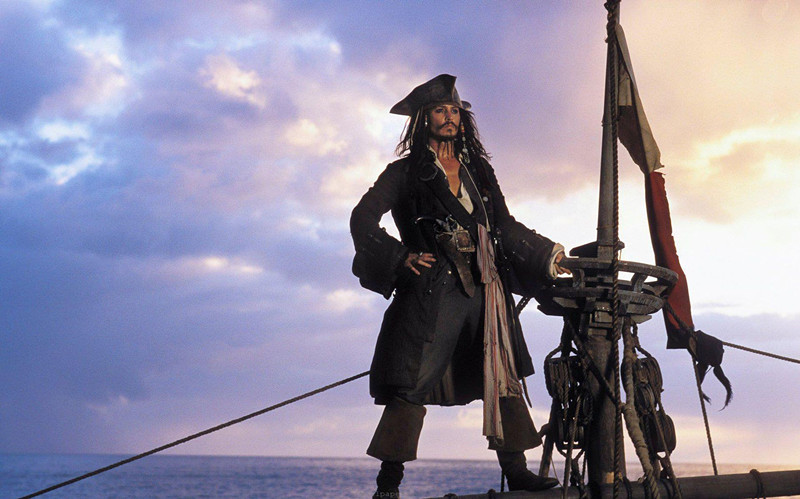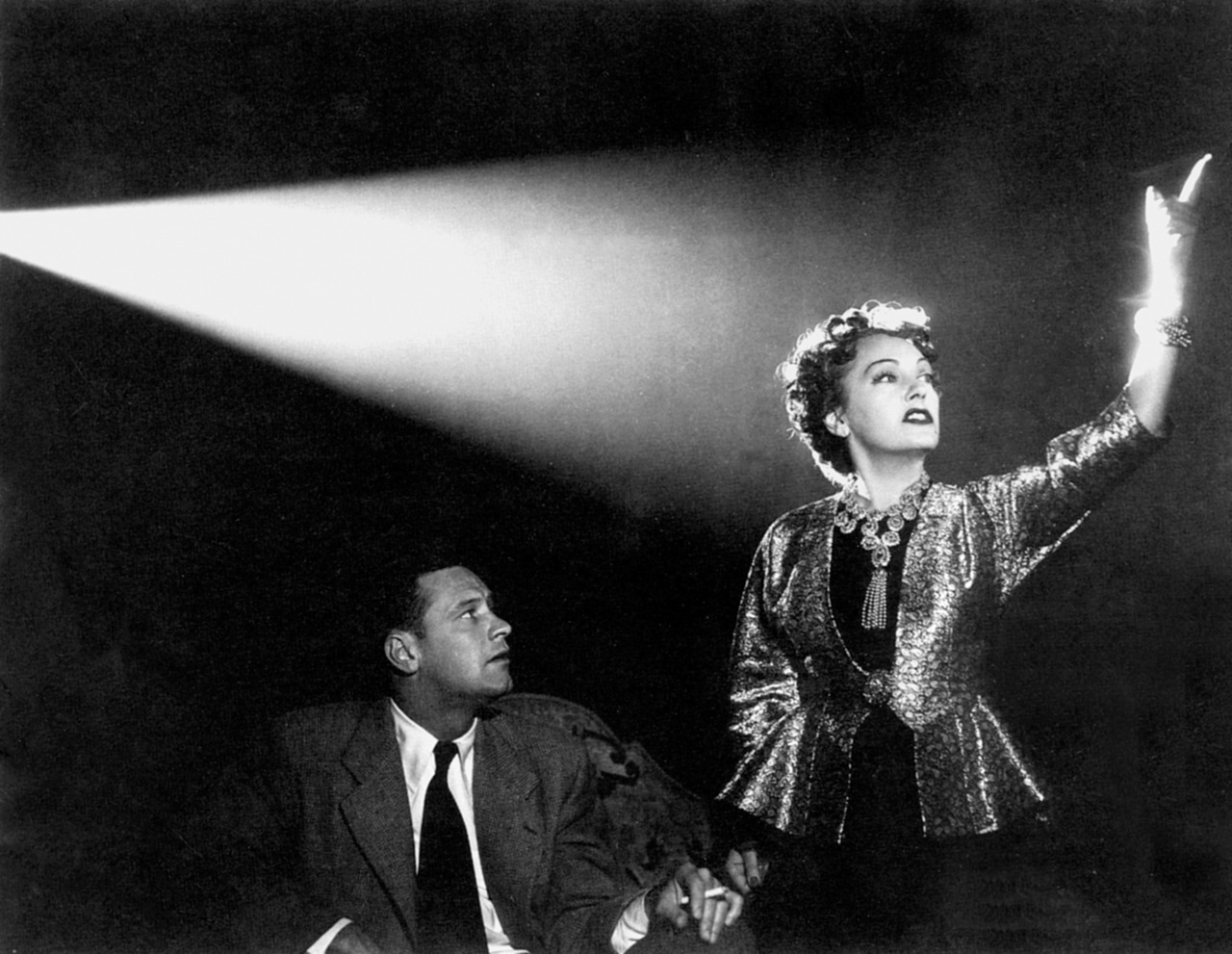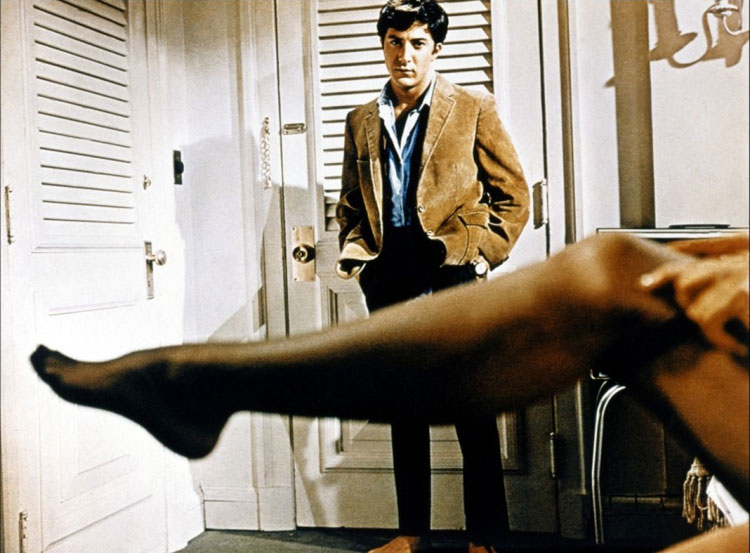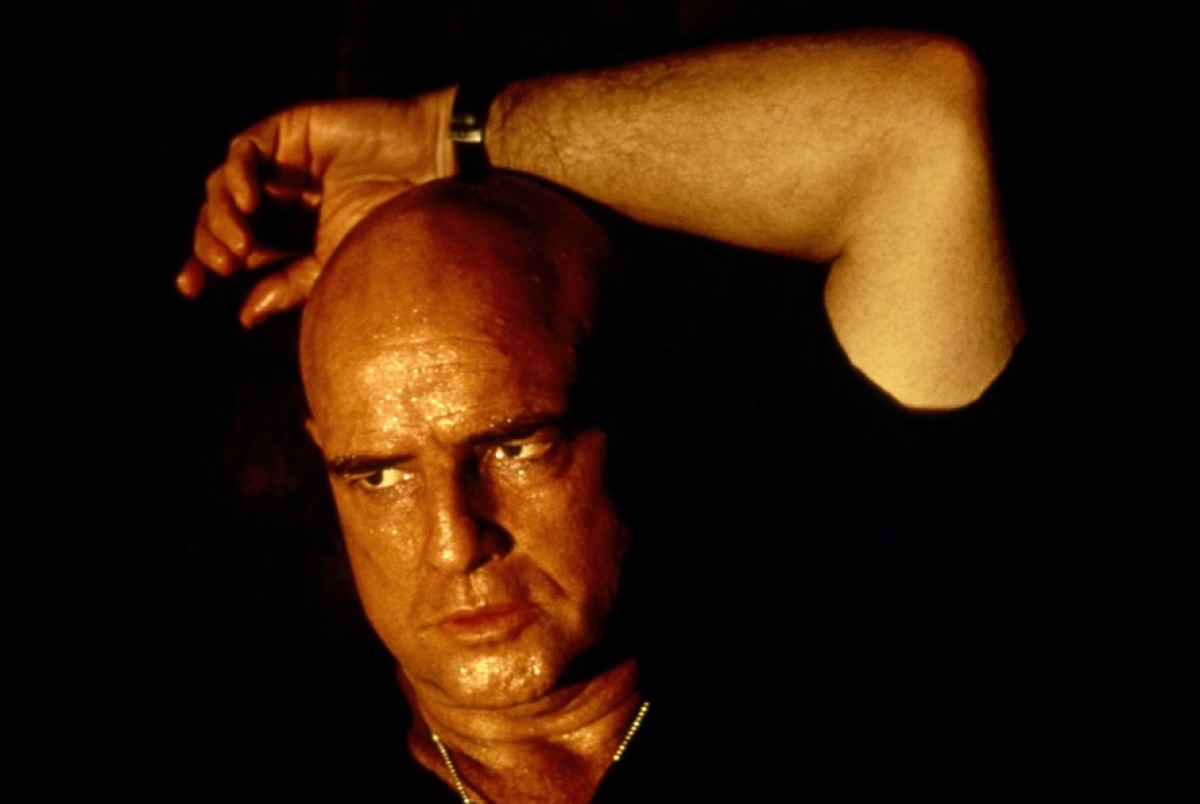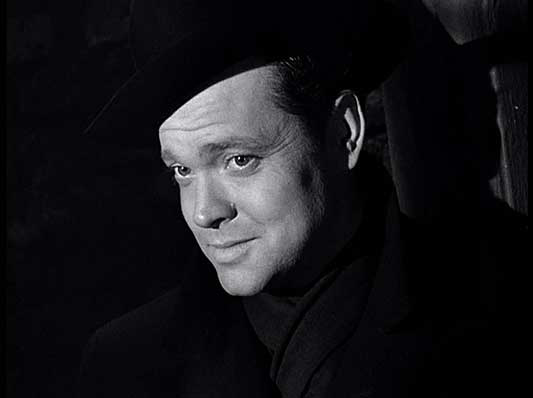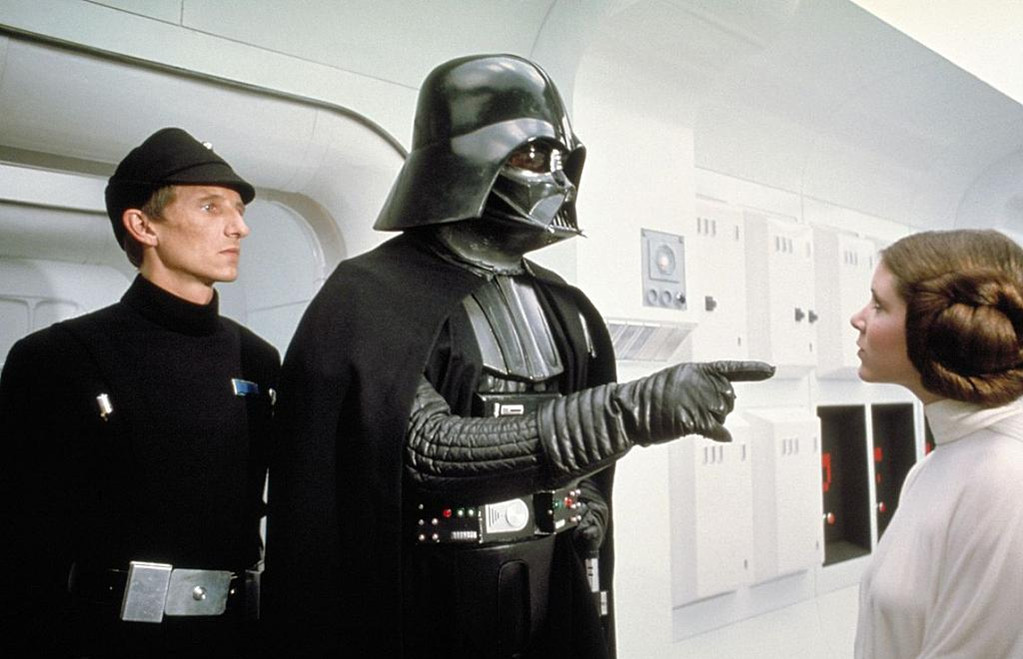7. Pirates of The Caribbean: The Curse of The Black Pearl (Gore Verbinski, 2003)
What it can teach you: Show and Tell. The physical particularities and personality tantrums of a character must be included in his entrance.
Captain Jack Sparrow stands on top of the sail of his ship, looking forward at the spur of the horizon and idealizing the efforts of his conquests (or failures) with eager imagination. The wind of the ocean caresses his face with the salty air of loneliness and mystery. He breaths it in as if it was perfumed with jasmine. He makes a jump to the platform of his boat, and in a sudden rush of cartoonish reveal, we discover that he is the captain of no authoritarian vessel, but of a sinking, wooden piece of crap.
He appears not to be summoned by distress despite the uneasiness of the situation. In fact, when his dropping raft crosses in front of three hanging, skeletal cadavers shining like polished charcoal and holding a sign which reads, “Pirates you are warned”, he salutes them with indifferent farce.
That´s when we realize that this is the magic of Captain Jack Sparrow, his ability to jump into the image with deceiving absurdity and ironic unease.
From the beginning of his entrance, we are enraptured with the rhapsody of his slippery movements. His body maneuvers in decorum, like a caked body filled with powder, falling apart like soaked bread.
Somehow he makes it to shore. Just when the remains of his ship are about to plunge and perish into the depths of the ocean, he reaches the deck of the port in a single step. He arrives to his destination in a perfect diagram of cinematic playfulness.
Jack Sparrow looks more challenging and endearing than ever, when battling the contours of death with flapping buffoonery.
8. Sunset Boulevard (Billy Wilder, 1950)
What it can teach you: Character entrances are best defined by atmospheres.
Billy Wilder described Norma Desmond´s eyes as: “two moonlit ponds, where strange animals come to drink at night.”
It is true, her eyes are watery, and they always seem to be dripping. After all, they are wet with the luminescence of past dawns.
The flecks and bolts of her voice have become increasingly remote and uncertain with the passing of time, still, with brief and unappeasable commands, she decides the fate of the world. Or that´s what she thinks at least, because the only world she rules is the one inhabiting within her egocentric mind, sulfating with the stench of delirium.
“Old age is not for sissies”-Bettle Middler used to say. Well, Norma Desmond will never be one of such sissies, since she has frozen herself inside a confined atmosphere of eternal disillusion. She ambulates within a capsule of paralyzed time warped by the stagnant scent of dilapidation, where she will never let herself grow old.
That is what oblivion does to you; it provides immunity against the tiny, heartbreaking ravages of time, as much as it falsely detaches you from the inevitability of decay.
William Holden´s character arrives to Norma Desmond´s house by the itch of randomness. He is running away from a pair of bloodhounds that have come to reclaim his car, and in the middle of a frenzied escape, the unemployed writer hides in the driveway of what appears to be an abandoned mansion. Curious and driven by the odor of solitude the place evokes, he moves forward to investigate the terrains of this rudimental erection of stone and marble.
This is where it all begins. An intruder trespasses into Norma Desmond´s private lunacies, and soon enough, he will be released into the precipice of her dissolute denial.
The tyrant tycoons of the movie business have forgotten her completely. They all have denied her the precious close-up she craves for. Nevertheless, every time Wilder feeds the audience with the warm closeness of her face, she reacts with maddening persuasiveness, as if triggered by the change of frame, as if conscious of being observed from up close, by strangers she is not supposed to be aware of.
It is possible that for a lapse of time, when watching and re-watching this film, we truly cease to exist within this earthly terrain, and we become dwellers of Norma Desmond´s world of dementia and self-indulgent extremes.
Through looped sessions of abandoned cinema, we transform into her eternal adorers, always surrendering to the mysticism of her eyes.
9. The Graduate (Mike Nichols, 1967)
What it can teach you: Character entrances must be all about a technique of economy.
Mrs. Robinson bursts into Benjamin´s room as if launched from a war cannon ready to strike down an enemy.
“I guess this is not the bathroom” – she articulates on the edge of the door, stabbing the air with her muted fierceness. “The bathroom is down the hall” – responds, Benjamin.
She steps inside without his permission. Through sharp bites of impatience, Benjamin tries to dismiss her away, but she lights up a cigarette and sits on his bed. She looks around, investigating in fast glances all the angles of the room, as if she was about to reclaim everything inside it with a sense of penance. She commands for an ashtray.
She never asks nicely for things, she orders and requests them even when they are never hers to demand. It is too hard for her to expose her vulnerability, if she was to ask for something nicely, she´d had to search deep in her heart for the place where her affections had rotten and her tenderness has dusted. And if she was to explore on the emotional muscles of her heart, she´d probably find the reasons for her rotten affections too unbearable, killing her ultimately in a single blow of gentle deception.
“Would you take me home, Benjamin?” – again, she infringes an order disguised as an appeal. Benjamin resists such requests through futile and arid struggle, the kind of struggle he has been attempting his entire life. He ends up taking her home of course.
From this moment on, they will talk to each other without saying a word, and they will hear what the other has to say without really listening.
This introduction is quick, sardonic, and impatient; the same kind of sex these two will have.
10. Apocalypse Now (Francis Ford Coppola, 1979)
What it can teach you: Anticipation is vital for introductions.
The whole film builds up to the moment of Colonel Kurtz revelation. When the audience finally meets Kurtz for the first time, we see him lying face up, on top of what looks to be a deathbed made out of pique shadows. He rises to greet us, like an agitated monster waking from slumber.
Kurtz has become entangled with bogs of abjection and nostalgia. Nevertheless, such entanglement has provided the most lucid of clearness.
His pale brows are always dripping with melted fat, born from the unusual punishment of the hellish humidity and the flaming heat, and his face is a paste of stiff and brownish matter, only similar in bits, to the hardened tissue of human skin.
His vulnerability belongs to a man of flesh and bones, but his prophetic wisdom has the godly virtue of exasperating nature itself. The echo of his barrel-organ voice crashes upon the jungle like a shattered rain of knifes. His repudiated trades are preserved intact and untouched by the sacrilegious masses of his myth, and the memory of his legend, is carried around through the veins of the rivers and by the traffic of wild animals.
Throughout the journey of General Willard through the jungle, we have seen his crew reduce in numbers as they face dejected outbreaks of tragedy and murder. They have been one inch away from losing grasp of their mental equilibrium, and their integrity, well, let´s just say that fertile gleam of their persona has been tarnished forever.
Still nothing has prepared them for the final encounter of their path. It has been bubbling up like carbonated soda.
Apocalypse Now is a film where time flattens out in round spheres, it all ends where everything begins. Never before, have we been faced with such a humane monster marked by such tragic sign.
Colonel Kurtz has not gone mad like his officials believe so, if anything, he has become the most realistic of creatures. He preaches the truth about the basic cores of human condition with more articulation than anyone has ever done it before: With the horror contained in it.
11. The Third Man (Carol Reed, 1949)
What it can teach you: Choose the right scene.
The third man is a film about shadows gravitating within other shadows. These are the shadows of men lost to the world.
Vienna is the city of exceptional and macabre energy that gives shelter to this story of disintegrating melancholia, betrayed love, and faked deaths. It is overall, a living organism in itself, jittering with surreal purity, where all the characters act out like lost children fighting their way out from this canyon of fog and shadows.
Harry Lime appears for the first time in a sequence of unprecedented mockery. Carol Reed plays and taunts with all the urban elements of the city available to him, as well as with all the cinematic tricks that imagination can administer: a roaming cat, the poisonous light of an apartment sneaking through an open window, the buffoonery of the music, and of course, the gloomy twilight of the night.
By the time he is revealed to us, we have been haunted by his ethereal presence in such degree, that we have dismissed the possibility of his carnal existence. Also, even if we have read it on the credits and posters before watching the film, by this point, we have forgotten that Orson Welles was cast in this movie as well.
His round and murmured face conjures upon us like a full moon of blither glimmer. Bathed by the insipid light of an upper apartment, his has the grin of a wizard about to forebode a curse through the edges of the darkened and wooden structure that frames him.
The American writer involved in this twisting plot roars his name- “Harry!” But the window upstairs is closed and the hypnotic light exposing him is killed in a quiet thumb. The mysterious man runs away from us and disappears among the fragmented geometry of the eclipsed alleys.
This is a scene of pure delight, one that explores the drilling themes of the film, and exorcises the thrilling idiosyncrasy of this enigmatic character.
12. Star Wars Episode IV: A New Hope (George Lucas, 1977)
What it can teach you: Character entrances must be memorable.
One of the few survivors from the Titanic, once said: “When I was being carried away by the fling of death, in a sudden rush of clarity, I saw the broken faces of strangers I had only seen for a few moments in a specific time of my life: a mother breastfeeding her daughter at church, under the shade of a tall tree a woman showing off to her friends, the engagement ring she had just received; a boy hitting his older brother with a damaged toy, among others. They were all like lost spirits swimming in a mirror.”
When my father took me to watch the re-mastered version of Star Wars some 20 years ago, there was a boy my age sitting next to me. He was alone at the movie theater, and his uneasiness revealed that this was his first time inside that dome of darkness. He had the eyes of an animal appeased by years of disappointment, and his skin was cracked by some kind of emotional drought.
When the martial music announcing the entrance of Darth Vader began to swell, and the tall figure merged in solid blackness appeared for the first time, the boy released a series of gasps; it was, as if he was throwing confetti in unexpected jubilee. His face, I believe, was glowing for the first time in many years.
There is nothing much I can say about the entrance of this character; I would simply fall short in description. Every time his image comes to mind, I perceive him as an undead man mummified by his metallic armor, and the sound of his voice resonates with the same amplitude and hollowness as the vastness of a dying galaxy. His story is one of shameful loss; it is the tale of a man deceived by the false charms of mercy. He is a terrestrial phantom in one of the most ethereal worlds of fairy and fantasy ever portrayed in film.
It is impossible to say, but maybe, at the final moments of my life, I won´t remember the manners in which Darth Vader penetrated the spectrum of cinema, nor the impact his immediate evilness had on me the first time I saw him choke a space trooper without even touching him… but the face of the boy sitting next to me, having his life changed forever by such sublime entrance.
Author Bio: Miguel Guerrero Becerra is a Mexican filmmaker who specializes in developing webseries. He is also a film instructor at two universities in Mexico. His favorite class to teach is writing and directing for television.
